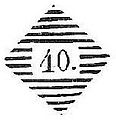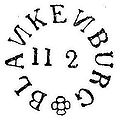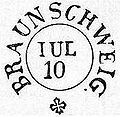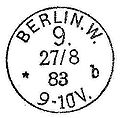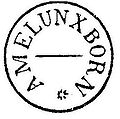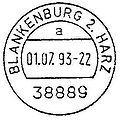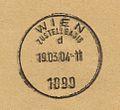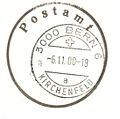Postmark
A postmark, or stamp for short, is a colored impression of the device of the same name on a mail item, which usually documents the place, date and time of the incoming mail and thus invalidates any postage stamps .
Postmarks are usually used for a longer period of time, with the date and, if necessary, the time being updated. Postmarks that are only used for a specific occasion are called special stamps . Postmarks whose date coincides with the day of issue of the canceled stamp are called first day cancellations . Other stamps applied with the postmark are secondary stamps.
history
The earliest known stamp comes from Venice in Italy in 1449 . The inscription of this simple stamp with the coat of arms of the Milanese Count Francesco Sforza read "Mediolarum Cursores" (roughly "Mailänder Kurier") and could already be a postal reference.
The development of the stamp industry is very difficult to follow, as almost no envelopes survived until the Renaissance . Only from the middle of the 17th century a large number of postmarks have been received. Usually they should facilitate the paperwork, which consisted of the documentation of the post location and the date of receipt and departure. In the beginning there were usually only single-line postmarks with the location. The first known stamp with an additional date is from the year 1661. Later stamps even show a time.
The so-called “paid” stamps, which confirmed postage paid in advance, were also created very early on . The first postmark of this type dates from 1681 and was in use in London . It bore the inscription "Paid One Penny". There is also a modern postmark from 1787 from the Imperial and Royal Postmaster Johann Georg Khumer from Friesach .
After the introduction of the first postage stamp in the 19th century, the use of the postmark changed. The stamp no longer served only as proof of the transport of the letter , but was knocked off the postage stamp , canceled it and prevented it from being used again.
In many countries such as B. in Great Britain were and are issued postage stamps with the portrait of the respective ruler. The postman was not allowed to deface this picture with his postmark. The cancellation had to be done carefully. In Spain in 1850, a postmark was designed in the form of a four-leaf clover, which only framed Queen Isabella's head on the postage stamp.
The path of a letter is documented with postmarks. In the first half of the 20th century, it was common to stamp letters both on delivery and on arrival at the destination post office. In addition, special modes of transport of the mail item were proven: z. B. by airmail or rail mail . Certain postal secondary stamps such as the R stamp ( response stamp ) indicate whether a letter was sent by registered mail. In addition, any postage charges to be taken due to missing or insufficient postage were indicated by means of a separate stamp.
The advertising potential of the postmark was recognized more and more, and so special postmarks were created that are only used for a limited time due to a special event. The first German special postmark was knocked off in Leipzig in 1863 .
The field post of the military often uses silent stamps . These are postmarks without the place or date.
Stamp shapes
At the time of the introduction of postage stamps around 1840, more than 200 stamp forms in various stamp colors were used, which opened up a wide field of activity for philatelists. Postmarks did not always contain the location or the date. A postmark without an inscription is called a "dumb stamp", a stamp with just a centered number is called a number stamp, a stamp with the location "local stamp", a stamp with the date "day stamp ". The stamps are also named after their shape: rectangular stamps , arched stamps, mill wheel stamps , round stamps, single and double circle stamps, etc.
Postmarks in different countries
Germany

Postmarks in Germany nowadays are found almost exclusively in black and in a circular shape (apart from the cancelers for machine and roller stamps and the recently used inkjet cancellations and postmarks). At the top of the circle is the location, in the middle the date and sometimes the time, and at the bottom the postcode . With the introduction of the letter centers , however, the postcode disappeared in their stamps, as this would not have correctly reflected the place where the letter was posted. Since March 1, 2004, a post horn has been used in the machine stamps of the letter centers that have been procured since then. The letter center itself can be seen from the circular inscription "BRIEFZENTRUM NN" (NN: number of the letter center), which replaces the location.

With the introduction of postcodes , postmarks changed their appearance. If the number within the double circle in brackets was initially placed in front of the place, in the FRG after 1961 the postcode was centered in the lower third of the stamp. According to the change in usage, the postcodes in the stamp were one to four-digit until 1974, from 1974 only four-digit postcodes were used. In addition, the place name was supplemented by the number of the respective post office in all places where there was more than one post office; this also applied to post offices with counters. As a result, for example, letters in Frankfurt were always stamped with "Frankfurt am Main 3" (central post office for the envelope), although Post Office 3 had no counter.
In the GDR, on the other hand, the postcodes were placed directly under the place names from 1964 onwards, and it was only after the reunification of Germany that stamps based on the Bundespost model were procured, which became generally binding with the introduction of the five-digit postcodes in 1993. With the introduction of the letter centers and the associated central processing, the postmark lost its meaning as a document of the place of delivery or postage, instead the text "letter center" was used in the area of the location, which is derived from the number (first two digits of the postcode) was added. The area where the zip code had been previously remained empty. For some time, however, postmarks have been in use in the letter centers, with a stylized post horn corresponding to the Deutsche Post AG logo at the point where the postcode used to be (and is still used at post office counters today).
In addition to the usual postmarks, there are special forms: These are primarily ship and rail postmarks, where the ship line or the train number in the stamp replaces the place, the stamps also have no postcode. Because of the more extensive data, railway postmarks are always oval and ship postmarks are larger than ordinary postmarks. For consignments for which it was found during transport in the rail mail car that the stamps had not yet been canceled, there were special rail mail stamps with the addition "subsequently canceled", since the original place of delivery could no longer be determined. Likewise, larger offices with delivery for the same purpose had a day stamp in which the comment "Subsequently devalued" was used in the lower part of the Deutsche Bundespost instead of the postcode. If there was no such stamp, the day stamp should be used and the subsequent cancellation should be marked with a handwritten "N". With the introduction of the letter centers, the delivery bases of Deutsche Post AG were equipped with rubber stamps for subsequent cancellation.
There are also various forms of special stamps . In some cases, these were created directly on behalf of the postal administration (e.g. for first-day postmarks or in the postal museum), but mostly on request when a special post office was set up on special occasions. In the past, special stamps were always round or oval, today they come in a wide variety of shapes, but what they all have in common is that they have a postcode and location.
Austria
Postmarks in Austria are called OT stamps, where OT is the abbreviation for place and day stamp. A wheel aisle stamp is used for manual stamping. Austrian postage stamps and postmarks are valued as collector's items all over the world , especially for first editions, as the Österreichische Post AG emphasizes.
Another special feature are regional post offices such as 4411 Christkindl or 2671 Küb and the special stamps they issue .
The postmarks are divided into task (post offices, special post offices and philately shops) and delivery (delivery bases).
Special stamps are used all year round. Per month one can assume that around 10 to 15 different special postmarks are in use for the most varied of occasions. Other special features are air mail handling, balloon mail, rocket mail and rail transport.
Postmark of the historical post office Küb , real used; August 2000.
Special feature: postal service envelope.
Switzerland
Post office stamp of Massagno ; April 2015.
Post office stamp Loco ; August 2000.
Stamp of the post office in Wangen at the Aare barracks; April 2015.
Stamp of the postal logistics center in Cadenazzo ; May 2015.
Postmarks as collectibles

With the rapid expansion of philately , interest in the postmarks on the receipts also grew. Own special catalogs for this special area of philately were created. Postmarks from the early days of the postage stamp and from the pre-philatelic era are particularly popular . So-called home collections, which document the postal history of the respective region using regional postmarks, or postmarks which prove a certain type of transport, e.g. B. certain routes or epochs of rail mail , or exotic such as Zeppelin mail or DO-X-Post . The association of collectors, researchers and examiners of cancellations of Germany philately are in the Poststempelgilde e. V. organized.
For a long time, special postmarks on certain occasions, especially first day postmarks on the first day of validity on first day letters, were considered particularly worth collecting. Some postal administrations reacted to this with a large number of special cancellations for philatelic purposes, in some cases stamps from the "collection by subscription" were also provided with such. On postage stamps from common collecting areas, courtesy stamps such as day dispatch stamps or first day special stamps are the rule, so stamps from real postal traffic (so-called requirement stamps) are all the more popular if they are clean and legible. Stamps that are not stamps at all, but are already printed on when the stamps are printed, are frowned upon.
Since the print runs of postage stamps are usually large, stamped copies are only valid if the stamp is completely legible, with the place name and date and is well centered. Postage stamps with fragmentary or smeared stamps, remnants of advertising stamps or wavy lines are considered to be of inferior quality; they are often used to stretch lots of stamps.
Fakes
With some issues it happens that canceled stamps are more valuable than unstruck copies, whereby the difference in value can be considerable. Hence it is in such cases counterfeiting of postal stamps. Basically, one can differentiate between two variants:
- False stamps : These are forged stamps. For example, rubber stamps are used instead of steel stamps, the cliché of which is somewhat more blurred due to the template and shows the same inaccuracy with every impression. Many false stamps can also be identified by using a single date, as no adjustment is possible. In the past, stamps were also copied, today laser printers are used for these forgeries . The imprint is very superficial and can usually be seen with a magnifying glass. Counterfeits are particularly difficult to detect when using inkjet printers, although these are very complex to produce because of the limited absorbency of the postage stamp paper in connection with the long drying time of the printer ink.
- Backdating : This variant uses real stamps where the date has been deliberately changed. Such forgeries are therefore very difficult to detect and can usually only be properly verified if the stamps used are "impossible", for example with postcodes, locations or post offices that do not match the stamp date or if the wrong stamp color is used.
Backdating and predating, which occasionally take place for philatelic purposes, represent a special case. This is regularly done, for example, with first-day postmarks, but it also occurs, for example, at special post offices or after a post office has been closed, when the post office is still making postmarks for collectors that are dated on the last day of opening. These are not real forgeries, but the actual day of the stamp is not documented.
Full forgeries are also rarely found . This means that both the postmark and the postage stamp are counterfeit.
Legal
In many cases, the postmark also has a legal significance for the determination of deadlines. For example, in the tax code (§ 122) there is a fiction of access, according to which a letter is deemed to have been received three working days after it was sent, unless another date of receipt can be proven. There are also regulations in the German Civil Code (Sections 355 and 375) that depend on the date of dispatch, which is ultimately documented by the postmark, unless a special posting certificate is issued. However, “the date of the postmark” was better known for meeting the deadline for competitions (compliance with the deadline for submitting entries), although this importance has decreased significantly in recent years due to new forms of participation. In the past, in addition to the date, the place of dispatch was clearly identifiable as a legally significant detail, at least in Germany this is only the case if the cancellation was not made in a letter center.
See also
Web links
- Stamp database, over 135,000 stamp devices, almost 400,000 locations in the index
- Postage stamp and postmark database, electronic catalog with value information for all postage stamps worldwide
Individual evidence
- ↑ Lothar Goedicke, Volkmar Werdermann: The designation of the postmark forms. An introduction to the terminology used in stamping according to Hans-Joachim Anderson . Poststempelgilde eV, Soest 2016, ISBN 978-3-9816173-6-8 .
- ↑ Official Journal of Deutsche Post, No. 328/1950. Subsequent cancellation of postage stamps that have not been canceled
- ^ Deutsche Post AG, instruction of the General Management 331-2 2350-Neg v. 10/22/97


